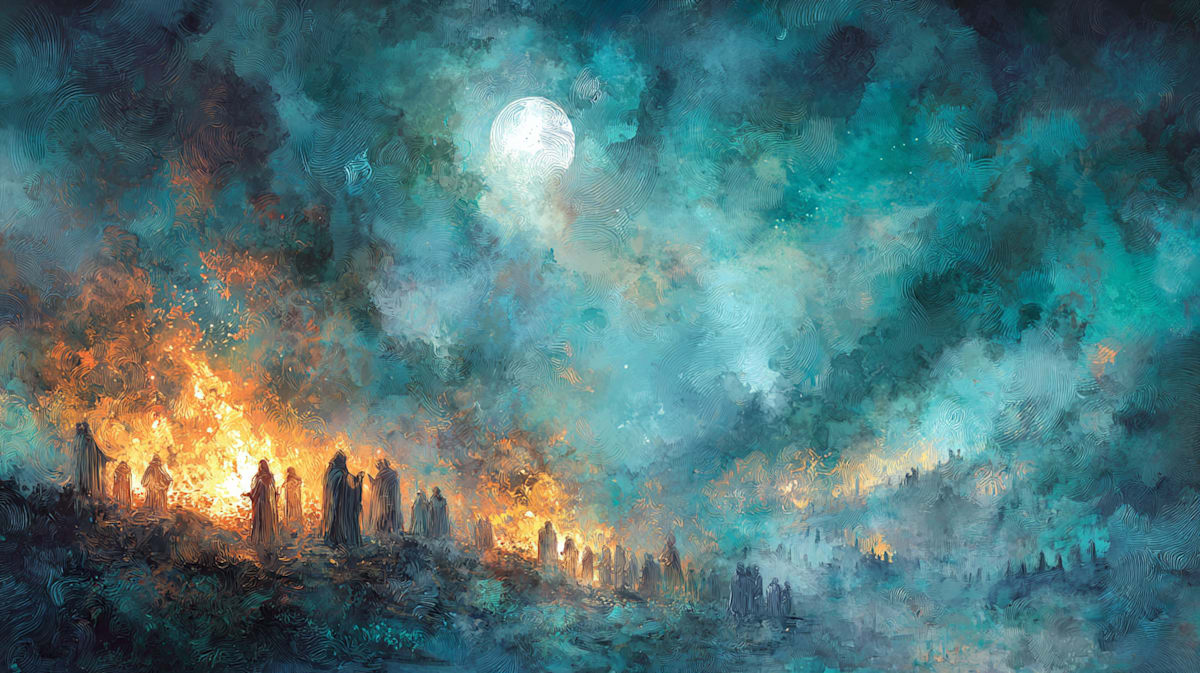Today, Halloween means candy corn, dollar-store cobwebs, and costumes ranging from terrifying to “why is that vampire wearing Crocs?” But before plastic skeletons hit the shelves of every big-box store, there was Samhain—the ancient Celtic festival that marked the end of harvest and the beginning of the dark half of the year.
And trust me, the Celts didn’t play around with their spooky season.
Samhain was more than bonfires and disguises; it was a sacred threshold. A time when the veil between the living and the dead was believed to thin, when spirits could wander freely, and when mortals tried their best not to get dragged into the Otherworld. So yes, your pumpkin spice latte has roots in rituals that once involved fire, prophecy, and feeding the dead.
Samhain: The Celtic New Year
For the ancient Celts, Samhain (pronounced Sow-in) wasn’t just a festival—it was the turning of the year. Harvest was over, winter loomed, and life slowed into survival mode. To mark the transition, they built great bonfires, herded animals into pens, and looked nervously over their shoulders in case the departed decided to pay a visit.
This wasn’t just superstition; it was cosmic housekeeping. The Celts believed that during Samhain, boundaries blurred. The natural and supernatural overlapped. The dead might return to visit their families—or demand offerings if those families had forgotten them.
And because no one wanted to become the Otherworld’s newest roommate, disguises became common. You dressed as something monstrous not for fun but for protection, hoping the spirits wouldn’t notice you were mortal. Early cosplay with much higher stakes.
Rituals of Fire, Prophecy, and the Dead
At Samhain, fire wasn’t just for warmth. Bonfires were lit on hillsides as both offerings and shields, thought to burn away harmful influences. People carried home embers from the great fires to reignite their hearths, symbolizing protection for the winter ahead.
Food played its part, too. Communal feasts left empty places at the table for wandering ancestors. It wasn’t about spooky theatrics—it was respect, a recognition that the living and the dead were temporarily sharing space.
And then there was prophecy. Apples bobbed, nuts cracked, flames read like fortune cookies. People sought glimpses of their fates during the liminal night when boundaries thinned. While your average Halloween party now has fortune-telling as a gag, for the Celts it was deadly serious.
From Samhain to Halloween
So how did Samhain’s fire-lit solemnity turn into a parade of candy wrappers? Blame (or thank) a combination of Christian influence and cultural adaptation. The Church set All Saints’ Day (and later All Souls’ Day) on November 1st and 2nd, folding the older festival into a Christian framework.
The result was a mashup: Samhain’s spirits and disguises met Christian rituals for the dead. “Guising” evolved into children going door to door for offerings. Stingy Jack’s Irish legend gave us the jack-o’-lantern, which swapped its traditional turnip for the far more carve-friendly pumpkin once it reached America.
And the bonfires? They’re still around—though these days you’re more likely to see them in a backyard fire pit than on a windswept hillside.
Why Samhain Still Captivates Us
Even though most of us aren’t leaving offerings for the ancestors on Halloween night (unless you count the fun-size Snickers), Samhain’s essence remains: it’s about liminality, thresholds, and transformation. The idea that for one night the ordinary world is peeled back to reveal something uncanny beneath.
That’s what makes it irresistible for writers like me. While Samhain rituals don’t appear directly in my books, the themes do. My selkies are creatures of thresholds—caught between land and sea, human and otherworld. My stories explore what happens when characters cross into liminal spaces, whether that’s diving into the ocean’s depths or facing the thin boundaries of memory and myth.
Closing Thoughts
Halloween may be wrapped in plastic these days, but its roots run deeper—back to bonfires on hilltops, offerings to the dead, and the unsettling thrill of a night when boundaries blurred. The Celts knew what we sometimes forget: that stories thrive in liminal spaces.
So the next time you light a jack-o’-lantern, remember you’re echoing a practice thousands of years old. And if you feel a chill, maybe don’t blame the autumn breeze too quickly.
